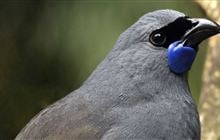Milestone for kōkako as population soars
Archived content: This media release was accurate on the date of publication.
Introduction
Recovery efforts over more than two decades have seen the North Island kōkako, one of Aotearoa’s most iconic birds, brought back from the brink of extinction, Conservation Minister Kiri Allan says.Date: 26 March 2021 Source: Office of the Minister of Conservation
“Protection of this species began in the late 1990s, after the kōkako population dropped to as few as 330 breeding pairs – around 1000 individual birds –scattered across the North Island.
“There are now 2000 breeding pairs of this secretive forest bird across the North Island, up from just 330 pairs when recovery efforts began,” Kiri Allan said.
“This is a true conservation success story, and a massive testament to the individuals, iwi and community groups who have worked alongside the Department of Conservation (DOC) to rebuild the population. Without their combined efforts this taonga may have been lost forever.
“The kōkako holds an important place in Maori mythology. Its iconic status is also due in part to its extraordinary song — ‘a loud, long, slow-paced sequence of rich, organ-like notes’, and often used by film-makers to evoke the sense and spirit of New Zealand native forests. It also features on our $50 note.
“Translocation and intensive predator control undertaken by DOC over many years in known kōkako habitats has been vital to rebuilding the species. Predator control work has included ground control and the use of biodegradable 1080 in aerial operations, the most effective tool for suppressing pests such as possums, rats and stoats in large rugged areas.
“At sites with effective ongoing predator control, kōkako populations have increased by up to 50 per cent each year. DOC’s predator control efforts at four North Island sites – Mataraua, Waipapa Ecological Area, Mapara and Boundary Stream – have resulted in significant boosts to the bird’s populations there, which is a testament to the value of this focussed pest work.
“But we are not resting on our laurels. DOC is contributing more than $1 million in operating expenditure this year to continue the fight against predators, with both aerial and ground control projects in kōkako habitats.
“In the last few months, DOC has completed several successful pest control operations at known kōkako sites as part of the ongoing Tiakina Nga Manu programme to protect the habitat for these and other native species. The Tiakina Nga Manu programme is a key piece of work for DOC as it strives to recover our taonga native species.
“Alongside that, the department’s Kōkako Recovery Group oversees efforts to protect the species. Five staff with ecological expertise, working with external experts, provide advice on kōkako protection methods, translocations and research, again contributing hugely to recovery efforts.
“A continuation of the partnership, dedication and commitment that has proved so successful, alongside ongoing research and monitoring, will undoubtedly ensure this precious bird will be around for future generations to enjoy,” Kiri Allan said.
A special event in Pureora Forest to celebrate this milestone included an early-morning forest walk, during which participants could hear the magical dawn chorus of the forest birds, with the kōkako among them.
Contact
For media enquiries contact:
Email: media@doc.govt.nz


